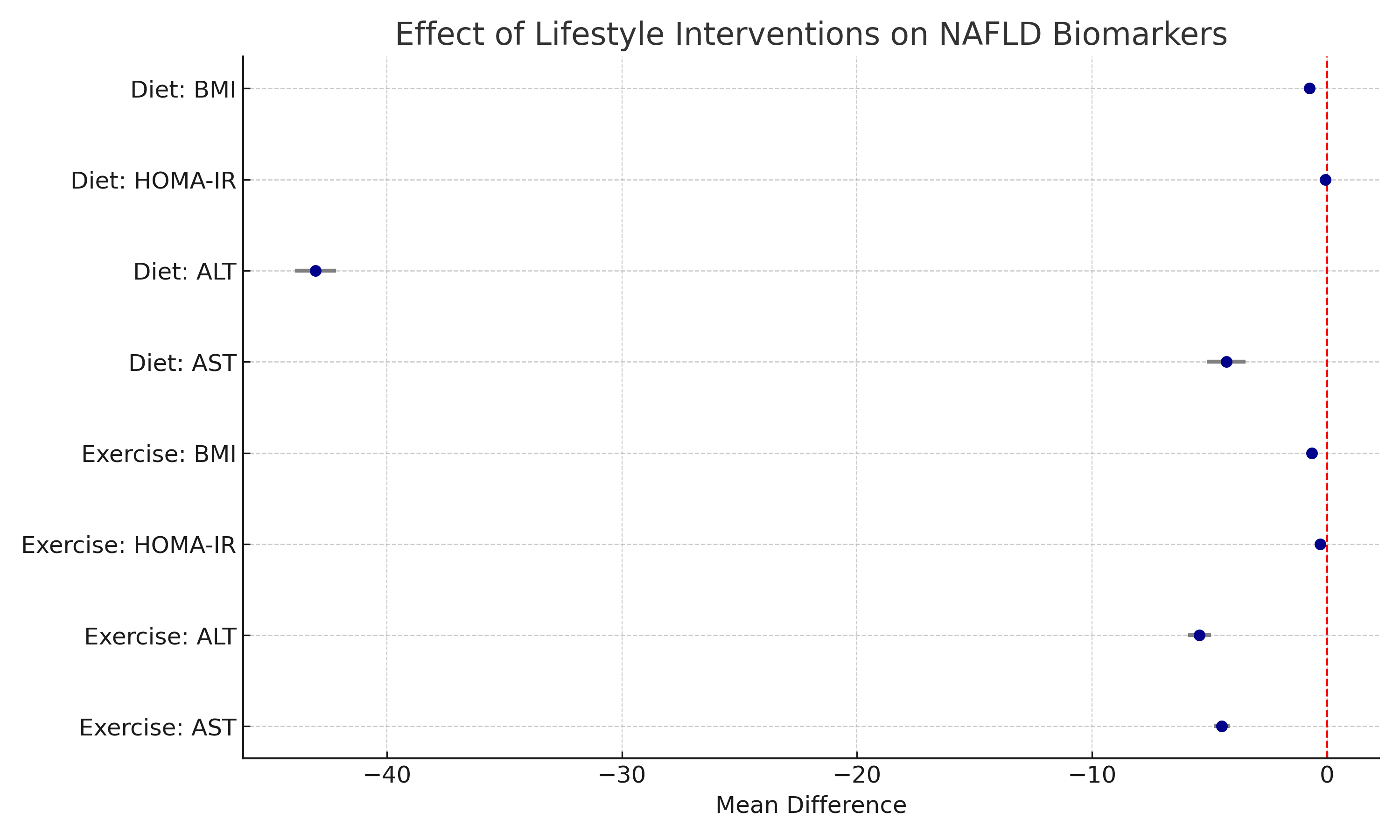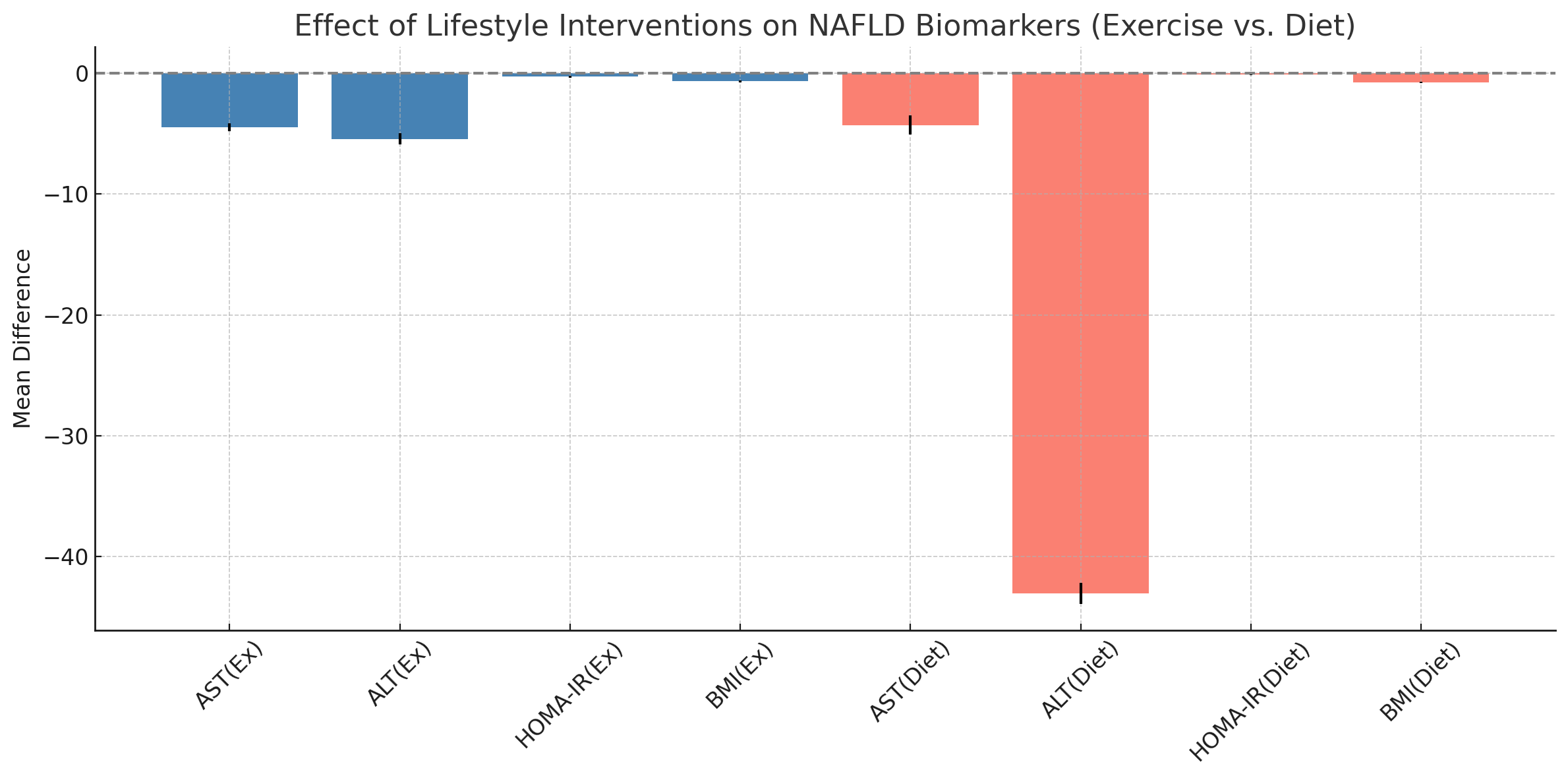Tuesday Poster Session
Category: Liver
P5808 - Lifestyle Modification in Early Non-Alcoholic Fatty Liver Disease: A Meta-Analysis and Subgroup Comparison of Exercise and Diet Interventions
Tuesday, October 28, 2025
10:30 AM - 4:00 PM PDT
Location: Exhibit Hall

Prince Shah-Riar, MD (he/him/his)
DHR Health, Edinburg, Tx
Edinburg, TX
Presenting Author(s)
Prince Shah-Riar, MD1, Mousumi Datta, MBBS2, Razia Afroj Tarin, MBBS3, Rishika Trivedi, MD4, Asif Zamir, MD, FACG5
1DHR Health, Edinburg, Tx, McAllen, TX; 2Mymensingh Medical College Hospital, Philadelphia, PA; 3Dhaka Medical College and Hospital, Kingston, ON, Canada; 4DHR Health, McAllen, TX; 5DHR Health Gastroenterology, Edinburg, TX
Introduction: Non-alcoholic fatty liver disease (NAFLD) is the most prevalent chronic liver disease globally and a growing public health burden. In the absence of approved pharmacologic therapies, structured lifestyle interventions are the cornerstone of management. This meta-analysis evaluates the effectiveness of physical exercise and dietary modification in reversing key clinical and biochemical markers of early-stage NAFLD, with a subgroup analysis comparing their differential impacts.
Methods: A systematic search of PubMed, ScienceDirect, Cochrane Library, ClinicalTrials.gov, Google Scholar, and PLOS ONE was conducted. Fourteen randomized controlled trials (RCTs) involving adult patients with NAFLD were included. Interventions consisted of either structured physical exercise or a controlled diet, compared to usual care. Primary outcomes included liver enzymes [AST, ALT], insulin resistance (HOMA-IR), and body mass index (BMI). Results were pooled using mean differences (MD) with 95% confidence intervals (CI). Subgroup analysis was performed to evaluate biomarker-specific effects by intervention type.
Results:
Both interventions improved overall quality of life and physical fitness.
As illustrated in Figure 1 and Figure 2, exercise uniquely improved insulin resistance, while both interventions demonstrated comparable benefits in liver enzymes and BMI. These findings suggest distinct metabolic advantages of exercise in NAFLD reversal.
Discussion: Structured exercise and dietary interventions significantly improve metabolic and hepatic outcomes in early NAFLD. Exercise appears to offer broader benefits, particularly in insulin sensitivity, supporting its prioritization in personalized lifestyle protocols. These findings may inform updated NAFLD guidelines and support integration of structured exercise into first-line management.

Figure: Figure 1: Forest plot comparing mean differences (95% CI) for exercise vs. diet on AST, ALT, HOMA-IR, and BMI

Figure: Figure 2: Bar plot showing subgroup effects of exercise vs. diet on NAFLD biomarkers
Disclosures:
Prince Shah-Riar indicated no relevant financial relationships.
Mousumi Datta indicated no relevant financial relationships.
Razia Afroj Tarin indicated no relevant financial relationships.
Rishika Trivedi indicated no relevant financial relationships.
Asif Zamir indicated no relevant financial relationships.
Prince Shah-Riar, MD1, Mousumi Datta, MBBS2, Razia Afroj Tarin, MBBS3, Rishika Trivedi, MD4, Asif Zamir, MD, FACG5. P5808 - Lifestyle Modification in Early Non-Alcoholic Fatty Liver Disease: A Meta-Analysis and Subgroup Comparison of Exercise and Diet Interventions, ACG 2025 Annual Scientific Meeting Abstracts. Phoenix, AZ: American College of Gastroenterology.
1DHR Health, Edinburg, Tx, McAllen, TX; 2Mymensingh Medical College Hospital, Philadelphia, PA; 3Dhaka Medical College and Hospital, Kingston, ON, Canada; 4DHR Health, McAllen, TX; 5DHR Health Gastroenterology, Edinburg, TX
Introduction: Non-alcoholic fatty liver disease (NAFLD) is the most prevalent chronic liver disease globally and a growing public health burden. In the absence of approved pharmacologic therapies, structured lifestyle interventions are the cornerstone of management. This meta-analysis evaluates the effectiveness of physical exercise and dietary modification in reversing key clinical and biochemical markers of early-stage NAFLD, with a subgroup analysis comparing their differential impacts.
Methods: A systematic search of PubMed, ScienceDirect, Cochrane Library, ClinicalTrials.gov, Google Scholar, and PLOS ONE was conducted. Fourteen randomized controlled trials (RCTs) involving adult patients with NAFLD were included. Interventions consisted of either structured physical exercise or a controlled diet, compared to usual care. Primary outcomes included liver enzymes [AST, ALT], insulin resistance (HOMA-IR), and body mass index (BMI). Results were pooled using mean differences (MD) with 95% confidence intervals (CI). Subgroup analysis was performed to evaluate biomarker-specific effects by intervention type.
Results:
- Exercise Subgroup: Significantly reduced AST (MD: -4.48; CI: -4.82 to -4.14), ALT (MD: -5.43; CI: -5.91 to -4.94), HOMA-IR (MD: -0.29; CI: -0.35 to -0.23), and BMI (MD: -0.66; CI: -0.74 to -0.58).
- Diet Subgroup: Reduced AST (MD: -4.28; CI: -5.09 to -3.48), ALT (MD: -5.04; CI: -5.91 to -4.16), and BMI (MD: -0.76; CI: -0.81 to -0.70), but did not significantly affect HOMA-IR (MD: -0.08; CI: -0.17 to 0.01).
Both interventions improved overall quality of life and physical fitness.
As illustrated in Figure 1 and Figure 2, exercise uniquely improved insulin resistance, while both interventions demonstrated comparable benefits in liver enzymes and BMI. These findings suggest distinct metabolic advantages of exercise in NAFLD reversal.
Discussion: Structured exercise and dietary interventions significantly improve metabolic and hepatic outcomes in early NAFLD. Exercise appears to offer broader benefits, particularly in insulin sensitivity, supporting its prioritization in personalized lifestyle protocols. These findings may inform updated NAFLD guidelines and support integration of structured exercise into first-line management.

Figure: Figure 1: Forest plot comparing mean differences (95% CI) for exercise vs. diet on AST, ALT, HOMA-IR, and BMI

Figure: Figure 2: Bar plot showing subgroup effects of exercise vs. diet on NAFLD biomarkers
Disclosures:
Prince Shah-Riar indicated no relevant financial relationships.
Mousumi Datta indicated no relevant financial relationships.
Razia Afroj Tarin indicated no relevant financial relationships.
Rishika Trivedi indicated no relevant financial relationships.
Asif Zamir indicated no relevant financial relationships.
Prince Shah-Riar, MD1, Mousumi Datta, MBBS2, Razia Afroj Tarin, MBBS3, Rishika Trivedi, MD4, Asif Zamir, MD, FACG5. P5808 - Lifestyle Modification in Early Non-Alcoholic Fatty Liver Disease: A Meta-Analysis and Subgroup Comparison of Exercise and Diet Interventions, ACG 2025 Annual Scientific Meeting Abstracts. Phoenix, AZ: American College of Gastroenterology.
